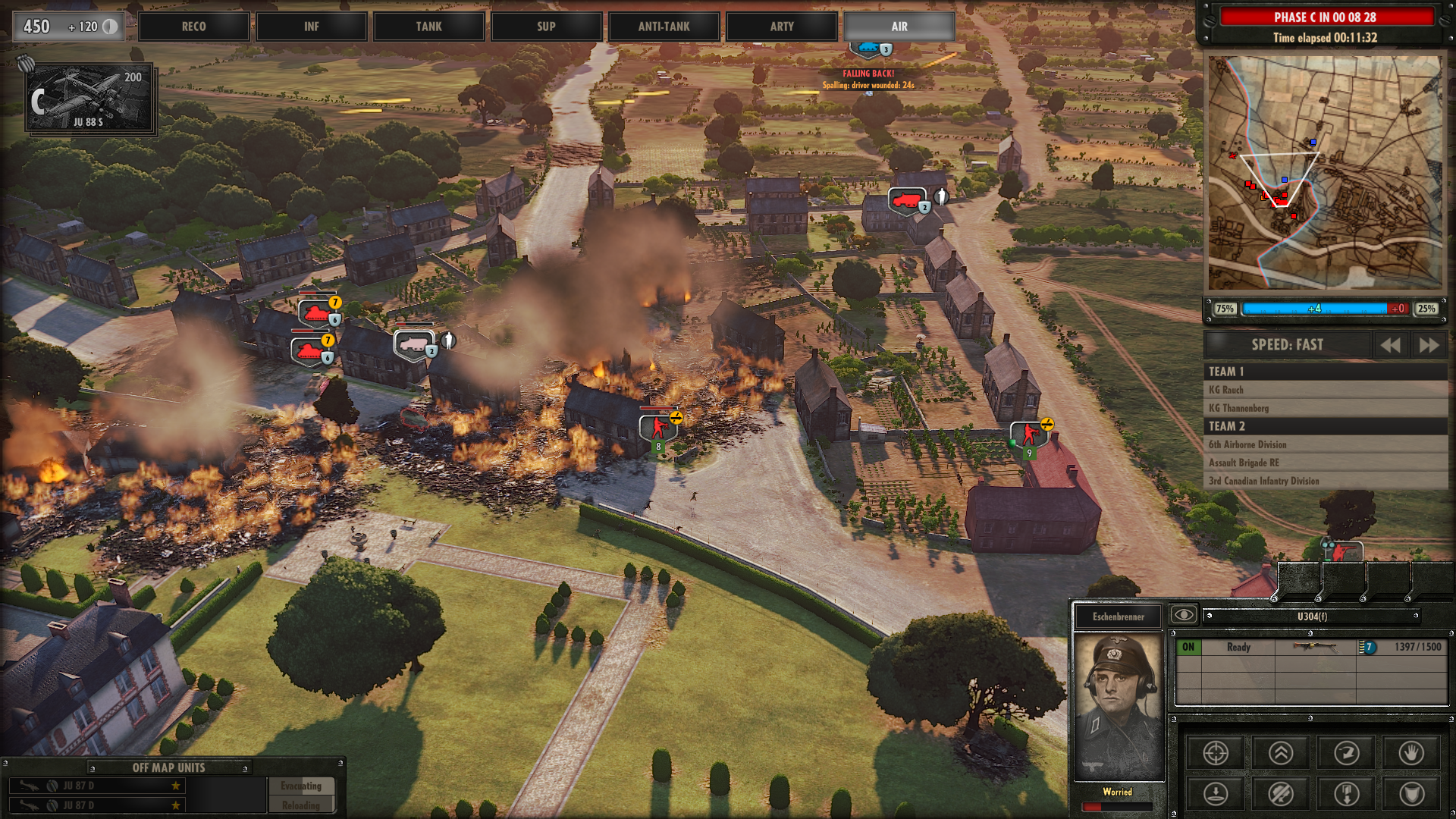Our Verdict
Disappointing campaign aside, Steel Division: Normandy 44 is a compelling and challenging real-time wargame.
PC Gamer's got your back
What is it: A deep real-time wargame charting the fight over Normandy in 1944.
Reviewed on: Intel i5-3570K @3.40 GHz, 8 GB of RAM, GeForce GTX 970, Windows 10.
Price: £35/$40
Release date: Out now
Developer: Eugen Systems
Publisher: Paradox Interactive
Multiplayer: Yes
Link: Official site
Steel Division is stressful. It’s a daunting fusion of the complexities of a World War II wargame and the micromanagement of an RTS, set amid the ruined towns and hedgerow hell of Normandy. This is why I’ve been unapologetically screaming—over explosions—at supply trucks for not getting to my artillery fast enough. I’m hoarse, but I’ve no regrets.
The Wargame series has always been demanding, and Steel Division is part of that series in everything but name. That’s a good thing, of course. It means large, tactically interesting maps, a vast number of authentic units crafted with an almost fetishistic attention to detail and battles that are as striking as they are challenging. But it’s blessed with greater focus than its predecessors, covering only a small area and period of time.
By zooming in on a very specific part of the war, more attention has been given to the men and machines doing all the fighting. Each unit is affected by stress. When an infantry unit is hit or finds itself close to an explosion, it’s pinned down and won’t take any orders. It can, however, be told to fall back to safety. Vehicles, on the other hand, may start to move backwards when the pressure mounts, eventually retreating. Fights, then, become more about controlling territory and pushing foes back.
This erodes the traditional rock, paper, scissors system that pervades strategy games. It still exists, but it’s complicated by shock and awe tactics. It doesn’t matter what units you’ve fielded, they’ll all freak out when the pounding of explosive shells fills their ears. And it can create dramatic fights, where weak infantry units can send heavy tanks packing by waiting for the perfect moment and striking from forests, making the men crammed inside panic.

It can be frustrating trying to chase units, however. Sometimes, scraps can devolve into a game of cat and mouse—it’s the only way to ensure that the enemy units don’t come back to haunt you. But frustration is part of the lesson: don’t let them run. If an enemy is pinned, or on its own in your territory, then it’s possible to capture them. It’s also something that’s taught in the campaign when it directs you to steal supply trucks, denying enemies more bullets and shells.
The campaign is effective at teaching the basics, but otherwise it’s disappointing. Its greatest crime is simply being dull. The Wargame series has always been a little sterile, but there’s always some dynamism, like an evolving campaign map—not here. It’s just a linear series of 12 missions with incredibly simple objectives. Hold this town. Take this bridge. Fight wave after wave of enemies. It forces you to play in a certain way, while the more open nature of solo or multiplayer skirmishes are where the game becomes more liberating.
Six different countries are represented in skirmish mode by 18 divisions split equally between Axis and Allies. Each contains a different selection of units that inform how they’re best employed, from the 101st Airborne’s elite infantry to the SS-Panzer’s beefy tanks.
Rather than just selecting a division, you’re creating your own custom-built battlegroup from a huge deck. This is particularly useful when constructing a highly-specialised force to support allies, though it can be hard, at first, to figure out how to pick between three Panzer IV Hs and a Tiger E Wittman. Phases have to be taken into account, too. Each match is split into three 10 minute phases, and some units are only deployable in phase B or C. So you’ll want to send your recon units in during phase A, while it might be worth investing in some heavy tanks for the final push.

Knowledge of World War II units and tactics certainly comes in handy. Experience helps as well, so testing the waters in some easy cooperative comp stomps is encouraged. Familiarity makes it easier to appreciate its myriad subtle complexities—how most units carry more than one weapon, and each can be turned off in an effort to conserve ammunition or make it focus on a specific type of enemy; or how a tank is made up of systems, armour, guns and even the men inside, and each can be damaged to reduce its effectiveness.
That’s why it shines in multiplayer. With a team around you, it’s possible to focus more on armour or artillery, letting you properly get to grips with specific units. And these fights benefit from letting you make a particular slice of the map your priority, instead of the whole thing. It’s easier to digest the battle and pick discrete objectives.
Skirmishes only contain one of two explicit objectives: control the most territory or destroy the most units. They’re not much more interesting than the campaign’s, but there’s more freedom in how you go about achieving them, as well as emergent, player-created objectives. One minute you might be trying to liberate a farm from the Germans, rushing at it while a teammate provides cover, filling the area with smoke using their artillery. The next, you might be trying to deny your enemy air superiority, fielding anti-air units so your ally can go on a bombing run.




The most spectacular matches are the 10v10 games, but while the chaos and massive-scale engagements can be fun, 2v2 feels like the sweet spot. It’s easier to communicate and make plans, and it makes you feel like you’re having a greater impact on the match, for better or worse. It also means that if you see your ally struggling, it’s likely that you can help, while in the larger games it might be impossible for you to trudge all the way across the map to save their bacon.
Steel Division is worth the time required to learn its intricacies. The moment-to-moment action is fraught with tension and overflowing with meaningful tactical conundrums, but it really comes to life when you’re plotting with others, carving up the map between you and figuring out ways to outsmart your opponents. It makes up for all the shouting you’ll be doing at innocent supply trucks.
Disappointing campaign aside, Steel Division: Normandy 44 is a compelling and challenging real-time wargame.

Fraser is the UK online editor and has actually met The Internet in person. With over a decade of experience, he's been around the block a few times, serving as a freelancer, news editor and prolific reviewer. Strategy games have been a 30-year-long obsession, from tiny RTSs to sprawling political sims, and he never turns down the chance to rave about Total War or Crusader Kings. He's also been known to set up shop in the latest MMO and likes to wind down with an endlessly deep, systemic RPG. These days, when he's not editing, he can usually be found writing features that are 1,000 words too long or talking about his dog.


